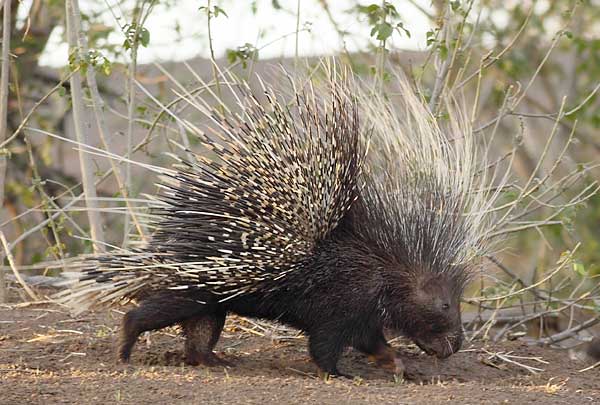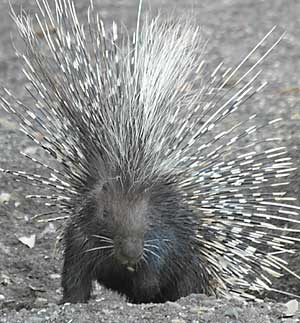Contact Details: Scotch Macaskill, Dirt Road Traders, Currys Post Road, Howick, KwaZulu-Natal, South Africa. Tel: +27 (0)82 578 2329. Privacy: Your privacy is guaranteed. See our Privacy Policy for more. This site accepts advertising and other forms of compensation - see Disclosure and Advertising for details. Site updated: 2022. Copyright © 2002 - 2022 Scotch Macaskill

| ||||||||||
|
||||||||||
|
SEE ALL
|
Porcupines Must Mate with Careby Roddy SmithFirst-time visitors to the bush have a fair idea what to expect when they see the "Big Five" — lion, leopard, elephant, buffalo, and rhino — but there are less celebrated animals that come as something of a revelation. One of these is the porcupine (Hystrix africaeaustralis). It is southern Africa’s largest rodent, and the second-largest in the world after the South American capybara. An adult porcupine weighs 11 to 12 kg, but it looks much bigger because of its quills, especially when it erects them in defensive display. The southern African porcupine belongs to the genus Hystrix, the crested porcupines, which are very different in appearance from the brush-tailed porcupines from West Africa and Asia. The obvious distinguishing characteristic of Hystrix is that the rear two-thirds of the body is armed with a ferocious hedge of black-and-white banded spines and quills, the spines being long (50 cm) and flexible, and the quills shorter (up to 30 cm), stouter and rigid.
The front part of the body is covered with coarse flattened hairs which form a crest on the head, giving the porcupine an appearance similar to boxing promoter Don King. Porcupines come in for their fair share of jokes connected with their prickly exterior and there is more than a grain of truth in some of them. They do indeed make love carefully — the female draws her tail up or sideways to expose the prick-free underside, and the male, who actually does have a relatively long penis, stands on his hind legs and puts his forefeet on the tail. Despite all these obstacles, porcupines are one of the very few animals besides humans that mate for reasons other than actual breeding. Porcupine pairs copulate every day. It is believed that this is necessary to maintain cyclic ovarian activity and that the female will not come into oestrus without it. Porcupines are monogamous, and pairs will maintain a small, exclusive territory within a larger home range (the difference being that a territory is defended against others of the same species whereas a home range may be shared) and will, apparently, fight intruders. Effective Defensive Weapons While the porcupine's quills are no deterrent to frequent sex, these sharp protuberances are nevertheless very effective defensive weapons. Like most non-predators, the porcupine’s first response when threatened is to try to escape, but if cornered it defends itself agressively. Initially it tries to scare off the attacker by stamping its feet, rattling its quills and grunting. Contrary to popular legend, porcupines cannot shoot their quills; they rush backwards or sideways at their attacker, and if the attacker fails to take evasive action quickly enough, the porcupine will jab the needle-sharp quills deeply into the attacker. The "grain" of the quills allows them to detach easily from the porcupine’s skin but acts like a microscopic barb to prevent them coming out of the animal they have been stabbed into. The quills are usually dirty and can cause infection and festering wounds on the faces or paws of predators which can, in turn, prove fatal. Often this happens to old animals who are too feeble to hunt bigger or faster animals than porcupines; I have twice seen old lions in terrible shape as a result of this.
Porcupines are nocturnal and forage solitarily or in pairs, spending the day in caves, rock crevices or holes and burrows (right). They are vegetarians, eating mainly roots and tubers which they dig up. They are also fond of fallen fruit (including that of the sausage tree) and of the bark of certain trees, and it is believed that their habit of debarking selected species of trees has a major influence on the cyclical succession of savannah ecosystems. Porcupines also gnaw on bones and accumulate piles of them in their dens. This is probably mainly for calcium and phosphate, but they have also been reported gnawing on siltstone, so it may be partly to grind their incisors which, like those of other rodents, grow continuously. In farming areas, porcupines can be a serious pest as they're not only fond of vegetables, but are also very destructive feeders. One camp where I worked which had a vegetable garden employed a full-time night watchman just to keep out the porcupines, which were not deterred by the electric fence which kept the elephants out (maybe the quills are insulators?). Roddy Smith is a wildlife conservationist and safari guide based in the Lower Zambezi National Park, Zambia. Return to Wildlife Articles |
|||||||||
|
|
||||||||||

